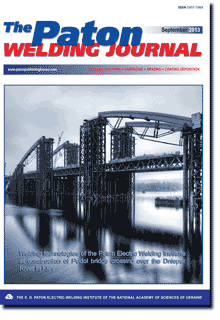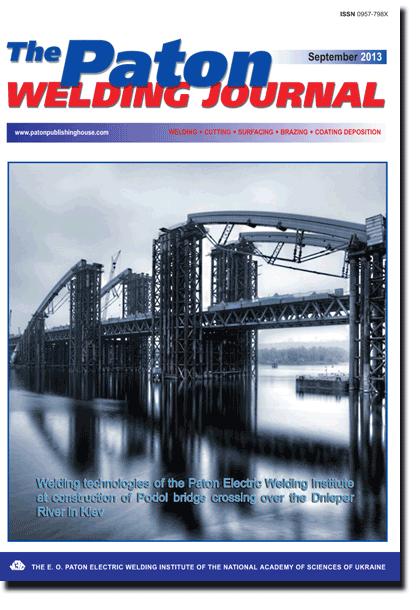| 2013 №09 (01) | 2013 №09 (03) |

The Paton Welding Journal, 2013, #9, 9-17 pages
INFLUENCE OF CHEMICAL COMPOSITION OF MICROALLOYED STEEL AND COOLING RATE OF HAZ METAL OF PIPE WELDED JOINTS ON ITS STRUCTURE AND IMPACT TOUGHNESS
A.A. RYBAKOV, T.N. FILIPCHUK, V.A. KOSTIN and V.V. ZHUKOV
E.O. Paton Electric Welding Institute, NASU. 11 Bozhenko Str., 03680, Kiev, Ukraine. E-mail: office@paton.kiev.uaAbstract
One of the most difficult tasks in manufacture of the gas-and-oil line pipes, from the point of view of technology of their welding, is fulfillment of the requirements of normative indices on impact toughness of HAZ metal of welded joint. The aim of present work is an investigation of effect of chemical composition of microalloyed steel and cooling rate of HAZ metal of pipe welded joints on its structure-and-phase state and toughness characteristics. Specimens of Kh70 grade steel of different chemical composition varying, mainly, in carbon content and different rate cooling conditions simulating HAZ metal of the pipe welded joints were studied using modern Gleeble-3800 complex. It is determined that a structure of bainite type, i.e. lamellar ferrite with strengthening second phase martensite-austenite-carbide - MAC or carbide phase), is mainly formed in the metal of studied chemical composition in sufficiently wide interval of the cooling rates. Density of distribution of the phase, its location (orientation), dimensions and morphology are determined, in preference, by chemical composition, and, to lesser degree, by metal cooling rate of the Vcool.8/5. In this connection, the possibilities of metallurgical factor influence should be use to greater extent in order to increase HAZ metal toughness. Strict limitation of weight fractions of the elements promoting formation of coarse ferrite packages with ordered carbide phase of lamellar morphology (for example carbon, niobium, molybdenum etc.) is also reasonable for formation of optimum structure and, respectively, improvement of HAZ metal toughness together with reduction of content of the detrimental impurities in steel (sulfur, phosphor and nitrogen) to minimum possible level. The results of investigations were used in production of pipes from low-alloyed steel of Kh70 grade for main gas-and-oil pipelines. 10 Ref., 3 Tables, 6 Figures.
Keywords: microalloyed steel, welded joint, heat-affected zone, cooling rate, microstructure, impact toughness
Received: 26.06.13
Published: 28.09.13
References
1. OTT-23.040,-KTN-314-09: Line pipes of large diameter. General specifications.
2. (2000) Offshore standard DNV-OS-F101. Submarine pipeline systems. Det Norske Veritas.
3. Morozov, Yu.D., Efron, L.I. (2006) Steels for pipes of main pipelines: state-of-the-art and tendencies of development. Metallurg, 5, 56-58.
4. Graf, M., Niederhoff, K. (1990) Toughness behavior of the heat-affected zone (HAZ) in double submerged-arc welded large-diameter pipe. In: Conf. on Pipeline Technology (15-18 Oct. 1990, Oostende, Belgium).
5. Kiryan, V.I., Semyonov, S.E. (1995) Assessment of fitness for purpose of microalloy steel welded joints of main pipelines. Avtomatich. Svarka, 3, 4-9.
6. Grabin, V.F., Denisenko, A.V. (1978) Metals science of welding of low- and medium-alloy steels. Kiev: Naukova Dumka.
7. Hrivnak, I., Matsuda, F. (1994) Metallographic examination of martensite-austenite component (MAC) of HAZ metal of high-strength low-alloy steels. Avtomatich. Svarka, 3, 22-30.
8. Terada, Y., Shinokara, Y., Hara, T. et al. (2004) High-strength line-pipes with excellent HAZ toughness. Nippon Steel Technical Report, 90, 89-93.
9. Grigorenko, G.M., Kvasnitsky, V.V., Grigorenko, S.G. et al. (2009) Actual problems of investigation of physical-mechanical properties of materials for welded and brazed structures. In: Coll. of NUK. Mykolaiv: NUK.
10. Uwer, D., Degenkolbe, I. (1977) Kennzeichnung von Schweisstemperaturzyklen hinsichtlich ihrer Auswirkung auf die mechanischen Eigenschaften von Schweissverbindungen. Stahl und Eisen, 24, 1201-1208.
Suggested Citation
A.A. RYBAKOV, T.N. FILIPCHUK, V.A. KOSTIN and V.V. ZHUKOV (2013) INFLUENCE OF CHEMICAL COMPOSITION OF MICROALLOYED STEEL AND COOLING RATE OF HAZ METAL OF PIPE WELDED JOINTS ON ITS STRUCTURE AND IMPACT TOUGHNESS. The Paton Welding J., 09, 9-17.The cost of subscription/purchase order journals or individual articles
| Journal/Currency | Annual Set | 1 issue printed |
1 issue |
one article |
| TPWJ/USD | 384 $ | 32 $ | 26 $ | 13 $ |
| TPWJ/EUR | 348 € | 29 € | 24 € | 12 € |
| TPWJ/UAH | 7200 UAH | 600 UAH | 600 UAH | 280 UAH |
| AS/UAH | 1800 UAH | 300 UAH | 300 UAH | 150 UAH |
| AS/USD | 192 $ | 32 $ | 26 $ | 13 $ |
| AS/EUR | 180 € | 30 € | 25 € | 12 € |
| SEM/UAH | 1200 UAH | 300 UAH | 300 UAH | 150 UAH |
| SEM/USD | 128 $ | 32 $ | 26 $ | 13 $ |
| SEM/EUR | 120 € | 30 € | 25 € | 12 € |
| TDNK/UAH | 1200 UAH | 300 UAH | 300 UAH | 150 UAH |
| TDNK/USD | 128 $ | 32 $ | 26 $ | 13 $ |
| TDNK/EUR | 120 € | 30 € | 25 € | 15 € |
AS = «Automatic Welding» - 6 issues per year;
TPWJ = «PATON WELDING JOURNAL» - 12 issues per year;
SEM = «Electrometallurgy Today» - 4 issues per year;
TDNK = «Technical Diagnostics and Non-Destructive Testing» - 4 issues per year.


